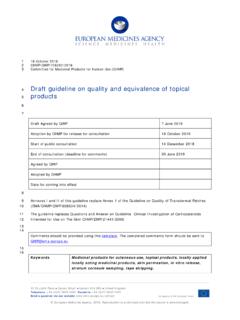Transcription of Can Topical and Oral NSAIDs Be Combined for Pain Relief?
1 |April 18, 2016 QuestionAre two nonsteroidal anti-inflammatory drugs better than one when it comes to treating pain?Response from Jenny Van Amburgh, PharmDClinical Professor & Assistant Dean for Academic Affairs, Department of Pharmacy and Health SystemsSciences, School of Pharmacy, Northeastern University Bouv College of Health Sciences, Boston,Massachusetts; Clinical Pharmacist, Harbor Health Services, Inc., Mattapan, MassachusettsPatients with moderate to severe musculoskeletal pain may experience suboptimal relief despite the use of a nonsteroidalanti-inflammatory drug (NSAID). Patients seeking additional pain relief may inquire about the use of Topical NSAID therapy in addition tooral NSAID , no guidelines exist on the use of combination oral and Topical NSAID therapy.
2 Regulatory bodies such as the US Food andDrug Administration (FDA) and the European Medicines Agency recommend the use of NSAIDs at the lowest dose necessary.[1,2] In2015, the FDA strengthened a previous warning for the increased risk for myocardial infarction and stroke with the use of NSAIDs .[3]Thus, the need for adequate pain relief must be carefully weighed against the potential risks of combination oral and Topical inhibit COX enzymes involved in prostaglandin synthesis to reduce inflammation. COX-1 inhibition by nonselective NSAID sincreases the risk for gastrointestinal bleeding and ulceration. NSAIDs with specific affinity for the COX-2 enzyme, such as celecoxib,have been developed to reduce the risk for gastrointestinal adverse events.
3 NSAIDs also may increase the risk for cardiovascularevents, possibly secondary to the imbalance of COX-2 blockade, which produces vasodilatory prostacyclin, and COX-1, which producesvasoconstricting and platelet-aggregating thromboxane.[2,4]The increased risk for cardiovascular events and cardiovascular-related death with the use of oral NSAIDs has been demonstrated inseveral studies.[5-8] Specifically, oral diclofenac, ibuprofen, and celecoxib have been associated with high cardiovascular risk, whilenaproxen has been associated with the lowest risk for adverse cardiovascular events. From a gastrointestinal perspective, agents suchas ketorolac and piroxicam demonstrate a high risk for gastrointestinal bleeding and perforation, while celecoxib, aceclofenac, andibuprofen are associated with fewer gastrointestinal adverse events at equivalent Topical NSAIDs carry the same black box warnings found on oral formulations for cardiovascular and gastrointestinal risk.
4 However,risks may vary with the specific agent and formulation.[9] To date, diclofenac is the only NSAID available in the United States for topicaluse. Although Topical diclofenac agents are designed to act locally at the site of application, consideration of the degree of systemicexposure and clinical manifestations is important. The pharmacokinetic data suggest that the use of Topical NSAIDs results in minimalsystemic exposure and therefore causes fewer cardiovascular and gastrointestinal adverse events than oral NSAIDs .[9-12] Comparedwith oral diclofenac, Topical diclofenac gel 1% (Voltaren ), Topical diclofenac solution (Pennsaid ), and Topical diclofenac (Flector ) are all associated with lower peak plasma concentrations and fewer systemic adverse events.
5 [9,10,12]In the single study available evaluating the combination of oral plus Topical NSAIDs , the combination of oral diclofenac and topicaldiclofenac solution was compared with oral and Topical diclofenac monotherapy. Topical diclofenac as monotherapy wasassociated with the fewest adverse events. Combination therapy was associated with a greater incidence of rectal hemorrhage,although an evaluation of gastrointestinal safety is difficult because patients in the study were allowed to take proton pump differences in cardiovascular risk between the treatment arms in this 12-week study were observed.[11,12] In terms of efficacy, oral ortopical diclofenac monotherapy was similar to combination therapy in all pain and physical function Topical and Oral NSAIDs Be Combined for Pain Relief?
6 Jenny Van Amburgh, of 34/20/16 9:33 PMIn addition to the limited evidence surrounding increased efficacy with the use of combination NSAID therapy, one must also considerthe ceiling effect with NSAIDs . In one study comparing analgesia with 400 mg, 600 mg, and 800 mg doses of ibuprofen, there was nosignificant difference in pain relief among these doses. Although higher doses have been shown to further reduce inflammation, thisdoes not equate to additional pain reduction.[13,14] In a systematic review, oral diclofenac 50 mg was associated with greater analgesiain postoperative pain than diclofenac 25 mg; however, diclofenac 100 mg did not show improved efficacy over diclofenac 50 mg,suggesting a ceiling effect at 50 mg.
7 [15,16]Despite the published pharmacokinetic data that suggest decreased systemic absorption of Topical NSAIDs , studies demonstrating theadditive analgesic effect of combination oral and Topical NSAID therapy have not been published. In the single study available,combination oral and Topical diclofenac was no better than either formulation as monotherapy, and it increased the risk for bleeding.[12]Additionally, the ceiling analgesic effect associated with NSAIDs further suggests that combination Topical and oral NSAID therapy maynot offer additional pain relief. Given the potential for increased risk, and without data to show improved efficacy with combinationtherapy, concomitant use of oral and Topical NSAIDs should not be routinely recommended, especially in patients already at greatercardiovascular or gastrointestinal author wishes to acknowledge the assistance of Safiya Naidjate, PharmD, RPh; Caitlyn Huffman, PharmD, RPh; and JazminTurner, PharmD, RPh, PGY1 residents at Northeastern University School of Pharmacy, in collaboration with Federally Qualified HealthCenters and the Program of All-Inclusive Care for the Elderly, Boston, M.
8 The role of dose reduction with NSAID use. Am J Manag Care. 2013;19:s273-277. Abstract1. Antman E, Bennett J, Daugherty A, Furberg C, Roberts H, Taubert KA. Use of nonsteroidal anti-inflammatory drugs: an updatefor clinicians: a scientific statement from the American Heart Association. Circulation. 2007;115:1634-1642. Abstract2. 3. US Food and Drug Administration. FDA Drug Safety Communication: FDA strengthens warning that non-aspirin nonsteroidalanti-inflammatory drugs ( NSAIDs ) can cause heart attacks or strokes. July 19, 2015. Accessed April 8, Fanelli A, Romualdi P, Vigano R, Lora Aprile P, Gensini G, Fanelli G. Non-selective non-steroidal anti-inflammatory drugs( NSAIDs ) and cardiovascular risk.
9 Acta Biomed. 2013;84:5-11. Abstract4. Olsen AM, Fosb l EL, Lindhardsen J, et al. Cause-specific cardiovascular risk associated with nonsteroidal anti-inflammatorydrugs among myocardial infarction patients--a nationwide study. PLoS One. 2013;8 Coxib and traditional NSAID Trialists' (CNT) Collaboration, Bhala N, Emberson J, Merhi A, et al. Vascular and uppergastrointestinal effects of non-steroidal anti-inflammatory drugs: meta-analyses of individual participant data from randomisedtrials. Lancet. 2013;382:769-779. Abstract6. Mass Gonz lez EL, Patrignani P, Tacconelli S, Garc a Rodr guez LA. Variability among nonsteroidal antiinflammatory drugs inrisk of upper gastrointestinal bleeding.
10 Arthritis Rheum. 2010;62:1592-1601. Abstract7. Garc a Rodr guez LA, Barreales Tolosa L. Risk of upper gastrointestinal complications among users of traditional NSAIDs andCOXIBs in the general population. Gastroenterology. 2007 02;132:498-506. Abstract8. McPherson ML, Cimino NM. Topical NSAID formulations. Pain Med. 2013;14:S35-39. Abstract9. Voltaren Gel [package insert]. Parsippany, NJ: Novartis Consumer Health, Inc.; Simon LS, Grierson LM, Naseer Z, Bookman AAM, Zev Shainhouse J. Efficacy and safety of Topical diclofenac containingdimethyl sulfoxide (DMSO) compared with those of Topical placebo, DMSO vehicle and oral diclofenac for knee 2009;143:238-245. Abstract11.




